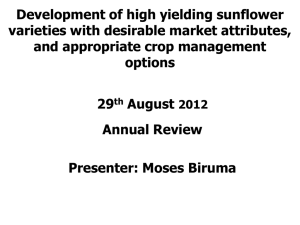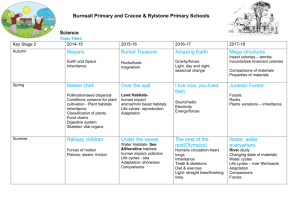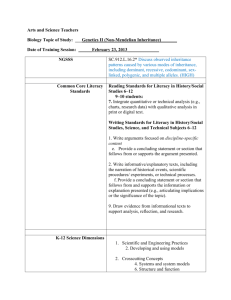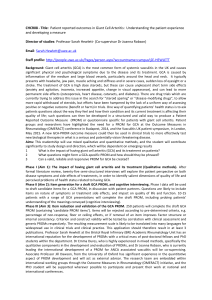Mode of inheritance and combining ability for seed yield
advertisement
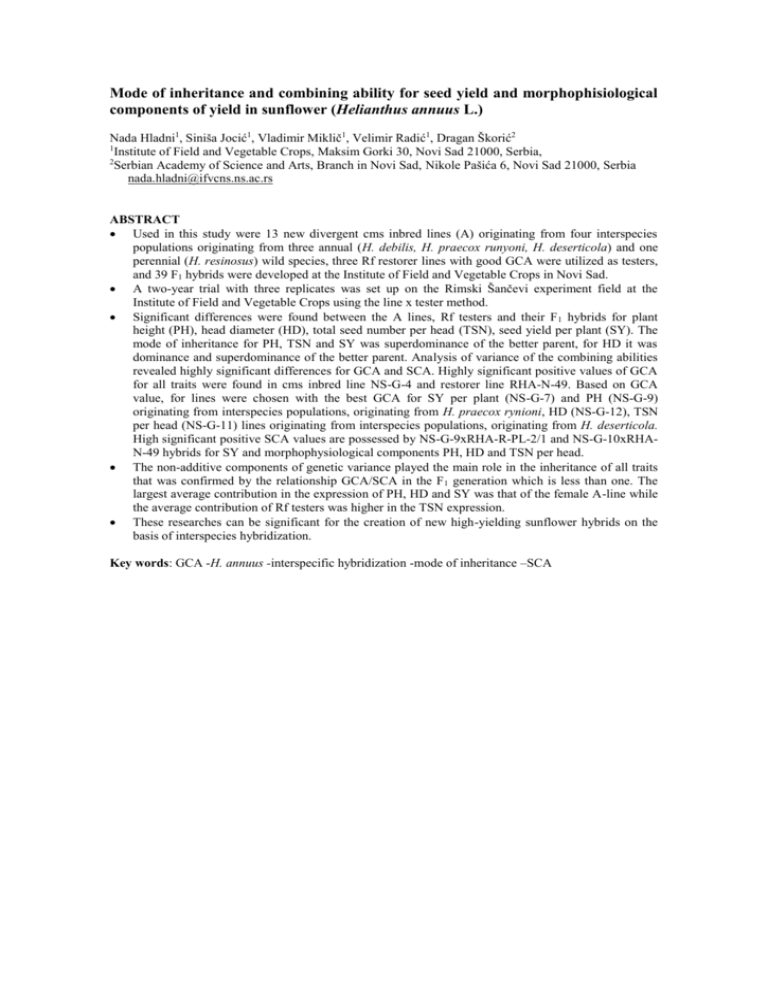
Mode of inheritance and combining ability for seed yield and morphophisiological components of yield in sunflower (Helianthus annuus L.) Nada Hladni1, Siniša Jocić1, Vladimir Miklič1, Velimir Radić1, Dragan Škorić2 1 Institute of Field and Vegetable Crops, Maksim Gorki 30, Novi Sad 21000, Serbia, 2 Serbian Academy of Science and Arts, Branch in Novi Sad, Nikole Pašića 6, Novi Sad 21000, Serbia nada.hladni@ifvcns.ns.ac.rs ABSTRACT Used in this study were 13 new divergent cms inbred lines (A) originating from four interspecies populations originating from three annual (H. debilis, H. praecox runyoni, H. deserticola) and one perennial (H. resinosus) wild species, three Rf restorer lines with good GCA were utilized as testers, and 39 F1 hybrids were developed at the Institute of Field and Vegetable Crops in Novi Sad. A two-year trial with three replicates was set up on the Rimski Šančevi experiment field at the Institute of Field and Vegetable Crops using the line x tester method. Significant differences were found between the A lines, Rf testers and their F 1 hybrids for plant height (PH), head diameter (HD), total seed number per head (TSN), seed yield per plant (SY). The mode of inheritance for PH, TSN and SY was superdominance of the better parent, for HD it was dominance and superdominance of the better parent. Analysis of variance of the combining abilities revealed highly significant differences for GCA and SCA. Highly significant positive values of GCA for all traits were found in cms inbred line NS-G-4 and restorer line RHA-N-49. Based on GCA value, for lines were chosen with the best GCA for SY per plant (NS-G-7) and PH (NS-G-9) originating from interspecies populations, originating from H. praecox rynioni, HD (NS-G-12), TSN per head (NS-G-11) lines originating from interspecies populations, originating from H. deserticola. High significant positive SCA values are possessed by NS-G-9xRHA-R-PL-2/1 and NS-G-10xRHAN-49 hybrids for SY and morphophysiological components PH, HD and TSN per head. The non-additive components of genetic variance played the main role in the inheritance of all traits that was confirmed by the relationship GCA/SCA in the F 1 generation which is less than one. The largest average contribution in the expression of PH, HD and SY was that of the female A-line while the average contribution of Rf testers was higher in the TSN expression. These researches can be significant for the creation of new high-yielding sunflower hybrids on the basis of interspecies hybridization. Key words: GCA -H. annuus -interspecific hybridization -mode of inheritance –SCA INTRODUCTION The main precondition for designing a model of a hybrid is to obtain parental lines possessing desirable genes so as to be able to pair up as parents lines that produce superior F 1 progeny over the existing hybrids for the largest number of agronomic traits. The genus Helianthus, besides constituting the basic genetic stock from which cultivated sunflower originated, continues to contribute specific characteristics for cultivated sunflower improvement (Seiler, 2010). Breeding for SY, yield components and the creation of a new sunflower ideotype require an increased use of wild Helianthus species in breeding programs (Hladni et al., 2011). Interspecific hybridization was applied in sunflower breeding, this process involves first the discovery of desirable genes in the wild Helianthus species and then their incorporation into cultivated sunflower genotypes (Škorić et al., 2007). Farrokhi et al. (2008) report that the non-additive component of the genetic variance has a bigger role in the SY inheritance. PH plays a major role in the creation of new SC-hybrids with a different plant model and high genetic potential for SY. The predominant role in the inheritance of the PH was held by the additive component of the genetic variance Marinković (2005), while Parameswari et al., (2004) determine a higher ratio of the non-additive gene effect. HD is a very important trait in the sunflower seed yield structure. The size of the HD influences the number of flowers and seeds per head which directly influence the SY per plant. The result of the research done so far on the inheritance of the HD differs. Ashok et al. (2000) determined a higher ratio of the additive component of the genetic variance in the inheritance of the HD, while Gvozdenović et al. (2005) determined that the non-additive component had bigger influence than the additive one. TSN represents one of the most important components of sunflower SY. It is conditioned by the number of formed tubular flowers, the degree of self compatibility, attractiveness towards the pollinators and the conditions of the external environment during flowering and pollinization of sunflower Hladni (2010). That the non-additive gene effect has the bigger influence in the inheritance of the TSN per head was stated by Goksoy et al. (2004). The objective of this study was to investigate the mode inheritance, general combining ability (GCA) effects in new divergent inbred lines obtained by interspecies hybridization, specific combining ability (SCA) effects of the F1 hybrids, gene effects, components of genetic variance, average percentage contributions of the lines, testers and their interactions with the expression of the studied morphophysiological traits. MATERIALS AND METHODS Used in the study were 13 new divergent (A) cms inbred lines NS-G-1, NS-G-2, NS-G-3, NS-G-4, NS-G5, NS-G-6, NS-G-7, NS-G-8, NS-G-9, NS-G-10, NS-G-11, NS-G-12, NS-G-13), 3 Rf-restorer lines, 39 F1 hybrids developed at the Institute of Field and Vegetable Crops in Novi Sad. Initially the plants were selected from the interspecies population RES-1, DEB-SIL-367-2, PRA-RUN-1321 and DES-1474-2, provided by Dr Gerald Seiler (USDA-ARS, Fargo ND, USA). Plants of four sunflower interspecies populations were subjected to inbreeding and used as male lines (B lines) in the initial crosses with several cytoplasmic male-sterile (cms) inbred lines from the IFVCNS breeding program. Obtained cms F 1 hybrids were backcrossed with B lines. Backcrossing of cms progeny was continued for 6-8 generations, to obtain 13 new cms inbred lines. Rf inbred line (RHA-R-PL-2/1, RHA-N-49, RUS-RF-OL-168) with good combining abilities were used as testers in the form of fertility restorers. The F 1 hybrids had been developed by crossing each tester with each female inbred line. The trial was carried out at the Institute's experiment field at Rimski Šančevi. There were three replications, and the experiment was designed according to the line x tester method. The lines and hybrids were planted manually at an optimum time, during mid April on a well-prepared soil. The plots consisted of four rows with 12 plants in each. The row-to-row spacing was 70 cm and the plants were spaced at 30 cm intervals within the rows. Each trait was analyzed on a sample consisting of 30 plants (10 per replicate) taken from the middle rows in each block. PH (cm) and HD (cm) was measured in the field at the stage of physiological maturity. SY per plant was determined by measuring of the total amount of seeds of the each plant acquired in free pollinization on a technical scale with the accuracy of 0.01 (g). TSN per head was determined by the count of full seeds per head. For the evaluation of the test of significance (t-test) of mean values of hybrids in relation to the parental average (Kraljević-Balalić et al., 1991). The mean values of the inbred lines and F1 hybrids were used to calculate the values of the combining abilities and assess the gene effects for morphophysiological traits using the line x tester method (Singh and Choudhary, 1976). RESULTS AND DISCUSSION The significant differences in PH, HD, TSN, SY per plant between the A lines and Rf testers on one side and their F1 hybrids on the other indicate the presence of genetic differences among the studied genotypes. The mode of inheritance for PH, TSN, and SY was super dominance of the better parent, for HD it was dominance and superdominance of the better parent (Tab.1). Superdominance as the mode inheritance for SY was reported by Jocić (2003). Table 1. Mean values, mode of inheritance of morphophisiological traits in sunflower Parents and hybrids PH HD TSN SY cm cm 1 NS-G-1 RES 93,5 22,10 844 52,7 2 NS-G-2 RES 99,0 21,79 981 57,5 3 NS-G-3 RES 104,4 21,26 1057 69,1 NS-G-4 DEB-SIL 4 116,4 20,85 1031 71,7 5 NS-G-5 DEB-SIL 114,2 20,18 1093 74,4 6 NS-G-6 DEB-SIL 109,8 21,73 924 56,0 NS-G-7 PRA-RUN 7 111,9 21,83 746 61,2 8 NS-G-8 PRA-RUN 93,0 22,03 872 80,7 9 NS-G-9 PRA-RUN 92,7 22,28 717 63,5 10 NS-G-10 DES 79,3 22,04 761 30,5 11 NS-G-11 DES 89,6 23,05 874 45,1 NS-G-12 DES 12 90,1 21,67 960 49,5 13 NS-G-13 DES 73,1 21,60 625 28,4 14 RHA-R-PL-2/1 116,1 19,13 707 34,1 15 RHA-N-49 99,5 14,28 848 27,0 16 RUS-RF-OL-168 114,0 16,99 903 31,0 17 1x14 139,6 h 23,4 d+ 1793 h 106,4 h 18 1x15 150,8 h 23,1 d+ 2080 h 115,0 h h h h 19 1x16 130,7 23,7 1845 103,7 h h h h 20 2x14 143,3 24,5 1787 110,2 h h h h 21 2x15 152,2 24,3 2190 119,6 h h h h 22 2x16 138,7 23,9 1867 101,6 h h h h 23 3x14 143,2 23,1 1692 100,9 h h h h 24 3x15 149,2 23,3 1968 108,1 h h h h 25 3x16 138,4 23,8 1639 104,0 h h h h 26 4x14 158,4 23,9 1789 117,3 h h h h 27 4x15 164,9 23,9 2249 124,0 h h h h 28 4x16 152,3 24,2 1921 126,4 h h h h 29 5x14 160,3 24,1 1903 123,5 h h h h 30 5x15 161,2 23,6 2155 135,2 h h h h 31 5x16 158,5 23,6 1820 110,1 h h h h 32 6x14 151,4 23,4 1874 114,7 h h h h 33 6x15 157,5 26,2 2315 132,6 h h h h 34 6x16 142,2 23,7 1786 110,1 h h h h 35 7x14 167,3 24,2 1684 136,7 h h h h 36 7x15 159,4 25,8 2102 143,2 h h h h 37 7x16 161,0 26,1 1682 130,3 h h h h 38 8x14 159,8 24,7 1667 131,3 h h h h 39 8x15 159,9 24,9 2069 137,7 h h d+ h 40 8x16 155,5 22,9 1686 137,8 h h h h 41 9x14 167,5 23,3 1777 139,4 h h h h 42 9x15 168,3 24,4 1875 127,8 h h h h 43 9x16 159,4 25,2 1536 132,7 h h h h 44 10x14 136,0 24,1 1628 103,0 h h h h 45 10x15 144,6 25,8 2062 119,4 h h h h 46 10x16 129,8 26,1 1683 85,8 h h h h 47 11x14 141,8 25,3 1895 113,8 h h h h 49 11x15 140,7 28,2 2379 111,2 h h h h 49 11x16 135,8 24,3 1801 110,5 h 50 51 52 53 54 55 12x14 12x15 12x16 13x14 13x15 13x16 LSD 0.05 LSD 0.01 140,6 h 140,3 h 135,8 h 138,0 h 140,9 h 131,6 h 2.17 3.26 26,2 h 28,6 h 26,6 h 26,2 h 27,8 h 27,7 h 0.300 0.450 1824 h 2024 h 1783 h 1755 h 2161 h 1675 h 28.36 42.53 107,4 h 109,9 h 111,3 h 105,6 h 116,3 h 97,6 h 5.59 8.39 The analysis of combining ability showed that the A lines and Rf testers differed significantly in GCA values. Highly significant cms line for GCA values for PH, HD and SY per plant was NS-G-7, for PH, TSN per head, SY per plant are NS-G-4 and NS-G-5. Rf tester line RHA-N-49 have highly significant GCA values for PH, HD, TSN per head and SY per plant. Based on the GCA values chosen were cms lines with the best GCA for PH (NS-G-9, NS-G-7) originating from PRA-RUN, HD (NS-G-13, NS-G-12) originating from DES, TSN (NS-G-11, NS-G-6) originating from DES and DEB-SIL and SY (NS-G-7, NS-G-8) originating from PRA-RUN. It is very difficult to combine all positive traits in one combination. By comparing mean values with GCA parent values in the F1 generation it can be concluded that the parents with higher mean values were in most cases better general combiners while lines with lower mean values were worse combiners. So lines with the best GCA for PH (NS-G-4), TSN per head (NS-G-5) have the highest mean values for that trait while the line with the worst GCA for PH (NS-G-13) has the lowest mean value for that trait. If the aim is the change of sunflower plant architecture, genotypes with shorter plant height (NS-G-10, NS-G-11, NS-G-12, NS-G-13) and negative GCA values, originating from interspecies population DES, are desirable in breeding programs (Tab.2). Table 2. GCA values and SCA hybrids for height and head diameter in sunflower inbreeds Parents and hybrids PH HD TSN SY 1 NS-G-1 RES -8,60 -1,428 25,11** -8,88 2 NS-G-2 RES -4,24 -0,603 66,85** -6,77 3 NS-G-3 RES -5,35 -1,439 -114,66 -12,88 4 NS-G-4 DEB-SIL 9,62** -0,858 105,27** 5,33** 5 NS-G-5 DEB-SIL 11,04** -1,044 78,49** 5,73** ** 6 NS-G-6 DEB-SIL 1,43 -0,403 110,42 1,87 7 NS-G-7 PRA-RUN 13,65** 0,742** -58,15 19,49** ** 8 NS-G-8 PRA-RUN 9,46 -0,675 -74,08 18,38** ** 9 NS-G-9 PRA-RUN 16,79 -0,542 -171,88 16,07** ** 10 NS-G-10 DES -12,15 0,464 -89,93 -14,50 11 NS-G-11 DES -9,49 1,086** 143,96** -5,42 12 NS-G-12 DES -10,07 2,292** -4,22 -7,70 13 NS-G-13 DES -12,10 2,408** -17,18 -10,74 14 RHA-R-PL-2/1 1,00** -0,506 -106,75 -1,07 15 RHA-N-49 4,12** 0,583** 239,75** 5,86** 16 RUS-RF-OL-168 -5,12 -0,077 -133,01 -4,78 LSD 0.05 (1-13) 1,25 0.174 16,37 3,23 LSD 0.01 1,88 0.261 24,56 4,84 LSD 0.05 (14-16) 0,29 0.084 7,86 0,78 LSD 0.01 0,44 0.126 11,80 2,33 SCA F1 PH HD TSN SY 1 1x14 -1,75 0,520** -6,64 -0,90 2 1x15 6,30** 0,761** -65,56 0,79 3 1x16 -4,55 0,231 72,20** 0,12 4 2x14 -2,44 0,409* -53,95 0,77 5 2x15 3,35** 0,845** 1,97 3,33 6 2x16 -0,91 -0,513 51,98** -4,10 7 3x14 -1,41 -0,916 32,61* -2,37 8 3x15 1,46 1,076** -38,11 -2,09 9 3x16 -0,05 -0,524 5,50 4,46 10 11 12 13 14 15 16 17 18 19 20 21 22 23 24 25 26 27 28 29 30 31 32 33 34 35 36 37 38 39 LSD 0.05 LSD 0.01 GCA SCA GCA/SCA 4x14 4x15 4x16 5x14 5x15 5x16 6x14 6x15 6x16 7x14 7x15 7x16 8x14 8x15 8x16 9x14 9x15 9x16 10x14 10x15 10x16 11x14 11x15 11x16 12x14 12x15 12x16 13x14 13x15 13x16 -1,14 2,24* -1,10 -0,72 -2,93 3,65** 0,06 3,02* -3,08 3,75** -7,29 3,53** 3,53** -2,59 2,23* 2,78* -1,59 -1,19 -1,78 3,69* -1,91 1,39 -2,90 1,51 0,72 -2,73 2,01 0,17 -0,04 -0,13 2,17 3,26 5,59 17,96 0,31 -0,747 -0,127 -0,474 -0,541 -0,911 -0,478 -0,700 -0,705 -0,752 1,131** 0,312* 0,103 -0,472 -0,077 1,684** 0,895** -0,030 0,391* -0,284 0,468** 0,296 -0,093 -0,618 0,604** -1,179 0,996** 0,824** -1,557 -0,421 0,571** 0.300 0.450 0,178 0,570 0,312 -90,29 22,51 67,78** 50,14** -44,01 -6,13 -10,97 83,38** -72,41 -32,10 39,61* -7,51 -33,73 22,21 11,52 174,13** -133,59 -40,54 -56,52 31,26* 25,26 -23,70 114,64** -90,94 53,65** -92,39 38,74* -2,64 58,07** -55,43 28,35 42,53 1909 13852 0,14 -4,19 -4,38 8,57** 1,65 6,40* -8,05 -3,37 7,63* -4,26 1,01 0,63 -1,64 -3,24 -3,72 6,97* 7,18* -11,34 4,16 1,37 10,80** -12,17 3,04 -6,52 3,48 -1,08 -5,49 6,57* 0,14 3,97 -4,11 5,59 8,39 8,03 75,05 0,11 Significant positive SCA value for all traits were demonstrated by NS-G-9xRHA-R-PL-2/1 and NS-G10xRHA-N-49. Hybrid NS-GS-10xRHA-N-49, which had been obtained by crossing one parent with a poor PH, TSN and SY GCA to another one that has a highly positive GCA for this traits (Tab.2). These results support those obtained by Škorić et al. (2000), who determined that crosses with a good plant height SCA usually involve one parent with high and one with low GCA values. Highly significant positive value for PH, HD and SY were demonstrated by NS-G-8xRUS-Rf-OL-168 and for HD, TSN and SY were demonstrated by NS-G-12xRUS-Rf-OL-168. The greatest highly significant positive SCA value for PH was found in NS-G-1xRHA-N-49, HD in NS-G-8xRUS-Rf-OL-168, TSN per head in NS-G9xRHA-R-PL-2/1 and SY per plant in NS-G-10xRHA-N-49 (Tab.2). In the inheritance of the PH, HD, TSN and SY per plant the non-additive component of the genetic variance had a predominant role as shown by the analysis of variance of combining abilities and analysis of genetic variance components. This is supported by the GCA/SCA ratio for PH (0.31), HD (0.31), TSN per plant (0.14) and SY per plant (0.11) in the F1 generation, which was below the value of one (Tab.2). A higher contribution of nonadditive genetic variance has been reported by Škorić et al. (2000) for the inheritance of PH, Hladni et al. (2004) and Parameswari et al. (2004) for the inheritance of HD, Goksoy et al. (2004) for the inheritance of TSN per head, Škorić et al. 2000 and Gvozdenović et al. 2008 for the inheritance of SY. By contrast, research found the additive component to be have been more significant in the inheritance of PH Marinković (2005), in the inheritance of HD Ashok et al. (2000), in the inheritance of TSN per head Goksoy et al. (2000), in the inheritance of SY Marinković et al. (2000). In this research the largest average contribution in the expression of PH, HD and SY per plant was that of the female A-line while the average contribution of Rf testers was higher in the TSN per head expression (Tab.3). Table 3. Average percentage contribution of female lines and tester lines and their interactions to expression of plant height and head diameter Average contribution PH HD TSN SY % % % % Female line 80,29 66,91 25,93 69,33 Tester line 10,96 7,86 63,19 10,80 Line x tester 8,75 25,24 10,89 19.8 According to (Škorić et al., 2000; Farrokhi et al., 2008) the mother lines had a significant proportion in the expression of the plant height (55.8%; 54.9%) and seed yield (51.4%; 62.8%). A higher average contribution of the interaction line/tester for seed yield (53.8%) was determined by Marinković et al. (2000). By studying the proportional contribution of inbred lines, testers and their crosses in the total variability, breeders come to different results with the same trait. The differences in the conclusions of different authors mentioned in this work can be explained by the differences in the plant material used in their studies. Studying GCA in relation to the origin lines we can observe that the lines of interspecies populations PRA-RUN the best general combiners for PH and SY per plant, lines from interspecies population DES are the best general combiners for HD, while the lines originating interspecies populations DEB-SIL and RES the best general combiners for TSN per head. The exception is a line from interspecies population DES NS-G-11 which is the best general combiners for TSN per head. The worst GCA for PH, TSN per head and SY per plant have lines originating from interspecies population DES, while for PH, HD and SY per plant have lines originating from interspecies population RES. It is very difficult to combine all positive traits in one combination. High significant positive SCA values are possessed by NS-G-9xRHA-R-PL-2/1 and NS-G-10xRHA-N-49 hybrids for SY and morphophysiological components PH, HD and TSN per head. These researches can be significant for the creation of new high-yielding sunflower hybrids on the basis of interspecies hybridization. ACKNOWLEDGEMENTS The paper is a part of the research work on the project 31025, financed by the Ministry of Education and Science of the Republic of Serbia. REFERENCES Ashok, S., N. Mohamed Sheriff, S.L. Narayanan. 2000. Combining ability studies in sunflower (Helianthus annuus L.). Crop Res. Hisar 20, 3:457-462. Farrokhi, A., A. Khodabandeh, M. Ghaffari. 2008. Studies on general and specific combining abilities in sunflower. p. 561-565. Cordoba, Spain. Goksoy, A.T., A. Turkec, Z.M. Turan. 2000. Heterosis and combining ability in sunflower (Helianthus annuus L.). Indian J. Agric. Sci. 70, 8:525-529. Goksoy, A.T., Z.M. Turan. 2004. Combining abilities of certain characters and estimation of hybrids vigour in sunflower (Helianthus annuus L.). Acta Agronomica Hungarica 52, 4:361-368. Gvozdenović, S., J. Joksimović, D. Škorić. 2005. Gene effect and combining abilities for plant height and head diameter in sunflower. Genetika 37, 1:57-64. Gvozdenović, S., I. Radeka, S. Jocić. 2008. Mode of inheritance and combining ability for seed yield in sunflower. p. 550-553. Int. Conf. „Conventional and Molecular Breeding of Field and Vegetable Crops“, Novi Sad, Conference Proseedings. Hladni, N., D. Škorić, M. Kraljević-Balalić, S. Jocić. 2004. Line x tester analysis for plant height and head diameter in sunflower (Helianthus annuus L.). II:497-502. In: Proc. 16th Int. Sunf. Conf., Fargo, North Dakota, USA. Hladni, N. 2010. Genes and Sunflower Yield. Monograph, p. 116. Foundation Andrejević, Beograd /Institute of Field and Vegetable Crops, Novi Sad. Hladni, N., D. Škorić, M. Kraljević-Balalić, S. Jocić, V. Miklič, N. Dušanić. 2011. Line x tester analysis for yield components in sunflower and their correlations with seed yield (Helianthus annuus L.). Genetika 43, 2:297-306. Jocić, S., 2003. Inheritance of yield components in sunflower (Helianthus annuus L.). (in Serbian). Ph.D. Thesis, Faculty of Agriculture, University of Novi Sad. Kraljević-Balalić, M., S. Petrović, Lj. Vapa. 1991. Genetics theoretical basis of the task. Faculty Agric., Novi Sad. Marinković, R., D. Škorić, B. Dozet, D. Jovanović. 2000. Line tester analisis of the combining ability in sunflower (Helianthus annuus L.). p. 30-35. In: Proc. 15th Int. Sunf. Conf., Touluse, France. Marinković, R. 2005. Application of line x tester analysis in the study of combining ability. Periodical of Scientific Res. Field and Vegetable Crops 41:87-101. Parameswari, C., V. Muralidharan, B. Subbalakshmi, N. Manivannam. 2004. Genetic analysis yield and important traits in sunflower (Helianthus annuus L.). Hybrids. J. Oilseeds Res. 21, 1:168-170. Seiler, G.J. 2010. Utilization of wild Helianthus species in breeding for disease resistance. p. 36-50. In: Proc. Int. Symp. “Sunflower Breeding on Resistance to Diseases”, Russia. Singh, R.K., B.D. Choudhary. 1976. Biometrical Techniques in Genetics and Breeding. Int. Bioscience Publishers, Hisar, India. Škorić, D., S. Jocić, I. Molnar. 2000. General (GCA) and specific (SCA) combining abilites in sunflower. p. 23-30. In: Proc. 15th Int. Sunf. Conf., Touluse, France. Škorić, D., S. Jocić, N. Hladni, G.P. Vannozzi. 2007. An analysis of heterotic potential for agronomically important traits in sunflower (Helianthus annuus L.). Helia 30, 46:55-73.

